Allen Tiller's Blog, page 29
December 18, 2018
Kangaroo Island UFO Sightings: 1964 & 1998
Kangaroo Island UFO Sightings: 1964 & 1998
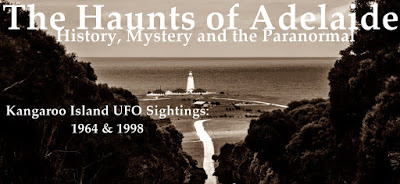
August 1969, apprentice radio technician, Alan Potter was working at the Adelaide Airport, servicing a radar unit. He tracked a Fokker Friendship aeroplane flying from Adelaide to Kingscote, Kangaroo Island, when suddenly, another object appeared on the radar, coming from the direction of Port Lincoln.
From the second object, a smaller object appeared to leave, and fly towards the Fokker Friendship aeroplane in a straight line.[1]
The two signals met abruptly over Rapid Bay before the smaller one returned to the larger one. Was it a UFO? Mr Potter believed it could have been.[2]
Potter worked in the Department of Civil Aviation for 25 years and was quoted on ABC Radio as saying of the incident; "I still don't think I believe in UFO’s but I can't explain this."More recently, in 1998, two people witnessed a UFO at Snelling Beach, Kangaroo Island. The witness watched the light move through the valley. As he watched, the light changed direction and came towards him. The colour then changed from yellow to intense white as it changed from a tennis ball size to a dinner plate size. It then changed direction once again, moving away from the witness, dropping its light intensity and size back to the tennis ball equivalent.
A little later the witness watched the light, and another light which came from the south, sit near each other for a small amount of time, before both went over the hillside and out of sight.
The object was reportedly silent the entire time it was viewed.
Have you seen a UFO – let us know over on our facebook page at: https://www.facebook.com/TheHauntsOfAdelaide/
Researched and written by Allen Tiller ©2018
Published on December 18, 2018 01:00
December 11, 2018
Kate Cocks: Pt V(b): The Stolen Generation
Kate Cocks: Pt V(b): The Stolen Generation
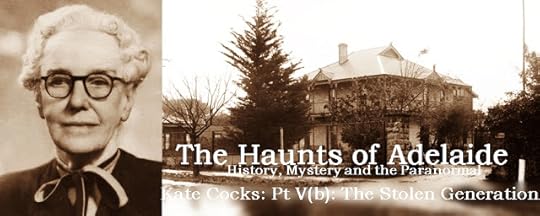
“It was proposed that a small cottage home be established for young women whose moral weaknesses have led them into difficulties from which they are unable to extricate themselves without some competent spiritual and material assistance, and which may necessitate their remaining hidden from the public for a time, or a severance from undesirable environment and influences”.(Kate Cocks quoted in Mission Story, Ivor Bailey May 1987 p.50.)
Goings on at The Kate Cocks Memorial Home for Babies were shrouded in secrecy, out of sight, out of mind. The reasons were two-fold in the eyes of the board. Firstly they considered an unwed mother a shameful act, secondly, keeping an air of secrecy about what the service does, would hopefully prevent children adopted out, coming back to the home later in life, asking questions about their mothers.
The pregnant mothers themselves were forced to earn their keep scrubbing floors, and doing dishes and other chores around the complex until their babies were born.
The outrage that followed the scandal of the Stolen Generation, The Forgotten Children and the Forced Adoption scandal was palpable, and repercussions from it, are still being felt today.
Victims often felt coerced, and it was common practice to ignore the three-week adopting out policy, and get the paperwork signed before the young mother could change her mind.
The Uniting Church issued the following apology in 2011 for the part they played in the scandal after being exposed to a Government inquiry
Apology
If mothers involved in the Kate Cocks Memorial Babies Home were coerced or forced to give their children up for adoption we unreservedly apologise to those affected. If children involved in the Kate Cocks Memorial Babies Home were forcibly removed from their parents, we unreservedly apologise to those affected.
Kate Cocks is much revered in some circles as South Australia’s first police woman, as a social reformer, and as a strong and influential woman who changed lives. In other circles, she is seen as a single-minded, brash opportunist who at every turn tried to force her religious views on society, to some she is baby stealer and a wrecker of family stability.
Whether you are for, against, or sit on the fence with your opinion of Kate Cocks and the life she led, one must remember that in the times that she lived, she forged ahead with what she believed and left her mark on the world, a single woman in a man’s world.
Researched and written by Allen Tiller © 2018
Bibliography
1917 '"AUBERT" OF SYDNEY', Daily Herald (Adelaide, SA : 1910 - 1924), 17 August, p. 3. , viewed 15 Aug 2018, http://nla.gov.au/nla.news-article124862828
1917 'FORTUNE TELLERS', Daily Herald (Adelaide, SA : 1910 - 1924), 25 June, p. 3. , viewed 15 Aug 2018, http://nla.gov.au/nla.news-article105413206
1936 'Life Story Of Miss Kate Cocks', The Advertiser (Adelaide, SA : 1931 - 1954), 6 October, p. 8. , viewed 07 Aug 2018, http://nla.gov.au/nla.news-article47749666
1936 'MINLATON', The Pioneer (Yorketown, SA : 1898 - 1954), 10 July, p. 1. , viewed 15 Aug 2018, http://nla.gov.au/nla.news-article199187964
1936 'The Record of a Pioneer Woman', The Advertiser (Adelaide, SA : 1931 - 1954), 13 October, p. 10. , viewed 07 Aug 2018, http://nla.gov.au/nla.news-article74327050
Bailey, Ivor (1987). Mission story : the story of the Adelaide Central Mission. The Mission, [Adelaide}
Cole, Christine A & Kashin, Janice & New South Wales. Department of Community Services (2008). Releasing the past : mothers' stories of their stolen babies. Sasko Veljanov, Yagoona, N.S.W
Find & Connect, 2018, Methodist Home for Babies and Unmarried Mothers (1937 - 1954), Commonwealth of Australia, viewed 6 August 2018, https://www.findandconnect.gov.au/gui...https://eagoodlife.wordpress.com/2013/02/05/bits-and-bobs/
https://www.adelaidenow.com.au/news/s...
Kelton, S., (2015, April 27). What was life like for SA’s first female cops?, The Advertiser, retrieved from https://www.adelaidenow.com.au/news/s...
Kemp, M, (2011). Uniting Church admits to forced adoption, The Advertiser. Retrieved from https://www.adelaidenow.com.au/news/s...
Marie Mune, 'Cocks, Fanny Kate (1875–1954)', Australian Dictionary of Biography, National Centre of Biography, Australian National University, http://adb.anu.edu.au/biography/cocks..., published first in hardcopy 1981, accessed online 15 August 2018.
S.A.’s Greats: The men and women of the North Terrace plaques, edited by John Healey (Adelaide: Historical Society of South Australia Inc., 2001
Uniting Church of South Australia & UnitingCare Wesley Adelaide Inc (2011), Joint Submission to the Commonwealth Contribution to Former Forced Adoption Policies and Practices 2011 Inquiry - Senate Standing Committee on Community Affairs. Retrieved from https://www.unitingcommunities.org/wp-content/uploads/2015/03/Joint-Submission-to-the-Senate-Inquiry-on-Former-Forced-Adoption-Policies.pdf
Williamson, B., (2015, Dec 3), A controversial start: Celebrating 100 years of women in South Australian Police force, ABC Radio Adelaide. Retrieved from http://www.abc.net.au/news/2015-12-01/celebrating-100-years-of-women-in-the-south-australian-police/6989272:
Published on December 11, 2018 01:00
December 4, 2018
Kate Cocks: Pt V(a): The Stolen Generation
Kate Cocks: Pt V(a): The Stolen Generation
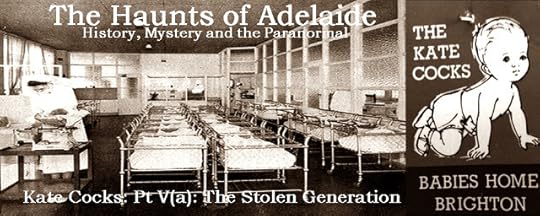
(As this is a long and contentious issue, this post will be spread out over a couple of weeks.)
In 1935, after serving 20 years in the South Australian Police Force, Kate Cocks retired from her position. Her main reason for leaving the police force was to care for her elderly dying mother.
Cocks, during her career in the police force, had often given so much of herself helping others, that she became known as “the friend of the down and outs”.
Often, she had allowed homeless girls to stay at her house at Parkside, and later suggested the Methodist Women’s Association open a home for women and children to find shelter. That home was eventually opened, located at 46 Wattle Avenue, Brighton in Old Oxford House, a former training college for young Methodist men, then a nursing home for a short time.
The Methodist Women’s Home Mission Association invited Cocks to become a voluntary superintendent of the home. Cocks, even in retirement, worked tirelessly in the home, taking in unmarried girls and their newly born babies. Cocks relied on her strong religious faith, with her welfare efforts an extension of her unwavering religious zeal and enforcing her own personal motto; “prevention is better than reformation”.
For Cocks, taking children away from a situation that could cause them harm, whether it be an abusive father, a poor family, or a mentally unstable parent, was better for a child in the long term over reformation.
Additions to The Methodist Home for Babies and Unmarried Mothers included the Wyld Maternity Home, an enclosed playground, and an extension of the wards and rooms. Later, in 1967, The Kate Cocks Memorial Adoption Agency was added to the complex.
After her death in 1954, the complex was renamed in Cocks honour as The Kate Cocks Memorial Babies Home until 1976 when the institution was closed.
The organisation continued as a daycare facility as part of the Central Methodists Mission, with the Adoption section of the organisation closing in 1978. The Kate Cocks Memorial Babies Home and many other church organisations have been accused of taking part in forced adoptions and being directly involved with the Aboriginal stolen generation.
The following Women’s Welfare Department Annual Report from 1954 emphasis’s the organisation's view of unwed mothers, adopting out of their children, and the shame it brought to the mother and her family.
According to the organisation;
‘Of the sins in this world a babe out of wedlock is not the worst, but the young mother carries the whole burden, often in the face of resentful intolerance. It is to help her through the difficult time and to make it possible for a new start and a second chance that the Methodist Home for Girls exists. Worked in conjunction with the Babies’ Home and with the facilities of the Wyld Maternity Home, the girls live normal lives under careful supervision; and the babes make their appearance with the help of qualified staff and doctors. It is not for these tiny people to bear the burden of their parents’ wrong-doing and whether they go home with the mother, stay on in the Babies’ Home, or are adopted into new families, their first few weeks are spend under their mothers’ care, and Matron’s supervision. Fifty girls have passed through the Home during the year.’
Women’s Welfare Department Annual Report – Methodist Conference – 1954 PR 9/38
According to an Advertiser article published in 2011, The Uniting Church of South Australia had previously denied the practice of forced adoptions but now accepted that it was “highly likely” (as quoted by Uniting Care Wesley chief executive, Simon Schrapel, 2011).
Schrapel was also stated in the article; “He said the decision to accept responsibility came after church leaders had read moving accounts to a current Senate inquiry into forced adoptions, which many victims said occurred at the Kate Cocks Memorial Babies Home at Brighton.”
Next Week: Kate Cocks: Pt V(b): The Stolen Generation
Bibliography on final post.
Published on December 04, 2018 01:00
November 27, 2018
Kate Cocks: Pt IV: The Crusade Against Psychic Exploitation.
Kate Cocks: Pt IV: The Crusade Against Psychic Exploitation.

1917, the Great War was devouring people and resources. South Australian women were scared for their sons, brothers and husbands fighting for the war effort. Women were doing anything they could to try and find out how their loved ones were doing on the war front, and whether they were alive, wounded, or dead. Women were turning to psychics in droves in the hope of divining some knowledge about their loved ones, and unfortunately a lot of “rogue” psychics began to spring up around the State, ready to look deep into their crystal balls, and part distraught women from their money, with fanciful tales divined for dollars.
So bad was the trend, that one fortune teller told an anxious mother, worried about her son, that he would be hung if she, the fortune-teller, did not intervene. To stop it happening, the mother would have to pay money to the psychic to prevent the tragedy!
Disgusted by this turn of events, Kate Cocks and her Women’s Police Department went on a crusade to stop the onslaught of “Occult Houses” that had started opening around Adelaide. Cocks had the law behind her, as The Police Act of 1916, Section 67, clearly laid out the law against Fortune Tellers (you can learn more about the laws at a previous post here: http://hauntedadelaide.blogspot.com/2017/10/trading-in-sorrow-criminal-clairvoyants.html)
Cocks said of the trend:
“Current events largely determine the exploitation of simple-hearted people by callous adventurers.' observed Miss Cocks. 'As an example, I quote the flood of fortune-telling that swept over the country in war time. 'It was a cruel thing, apart from its ridiculous aspect. Women opened 'occult' apartments. and undertook to read the future for varying amounts of payment, according to the financial position of their clients. These were mostly women of the nervy type who were living at high pressure on account of having loved ones at the war. 'It was a frightful thing to exploit such anxiety, and we did not pause in our ruthless cleaning of those crystal-gazers until they were no more.” (The Advertiser, October 1936)
Cocks crusade against psychics really took off in 1917, when she was involved in a number of stings bringing down fake psychics around Adelaide. The 25th case in succession of cases against fraudulent psychics was a young Adelaide man who had put an advertisement in the local newspapers, asking for anyone wanting fortunes told, to send him penny stamps through the mail to a Sydney address.
The scammer had set up his rouse at the Adelaide Post Office so that any mail addressed to “Hubert, Box 440” in Sydney, leaving from Adelaide, be held for a few days so he could pick it up.
On receiving a letter, he replied asking for money for more psychic insights. What he wasn’t counting on was the ingenuity of Cocks, who caught the rogue psychic out. He ended up with 3 months gaol, and 25 pound fine for his efforts and was recorded as a “rogue or vagabond” in his court records.
A little over a decade later, in 1929, Cocks was still pursuing psychics under Section 67. At the Royal Adelaide Show, she had set up a sting, and had her fortune read by a number of palm readers, and crystal ball psychics.
5 psychics were arrested and charged under Section 67, being; Frances Alexander, George Mereno, Mary Stanley, Julia Stanley and Alick Alexander. All pleaded guilty, but in ignorance of the law. Each psychic was fined 10 Shillings for their crime and 10 shillings court costs. ($77 AUD total costs each in today’s money).
Today the Police Act 1916, Section 67 is no longer used, instead we have a newer law meant to stop fake psychics. The law is now known as The South Australian Police Act, Section 40 Part 8, and is enforceable (even though I am not aware of anyone who has been arrested under the act, even though I am aware of several fraudulent psychics!)
Section 40 Part 8 of the South Australian Police Act (https://www.legislation.sa.gov.au/LZ/...)
40—Acting as a spiritualist, medium etc with intent to defraud A person who, with intent to defraud, purports to act as a spiritualist or medium, or to exercise powers of telepathy or clairvoyance or other similar powers, is guilty of an offence.
Maximum penalty: $10 000 or imprisonment for 2 years.
You can also report fake psychics to scam watch!
https://www.scamwatch.gov.au/types-of...
NEXT WEEK: Kate Cocks: Pt V(a): The Stolen Generation
Researched and written by Allen Tiller © 2018
Bibliography on final post
Published on November 27, 2018 01:00
November 20, 2018
Kate Cocks: Pt. 3: From Probation to Police.
Kate Cocks: Pt. 3: From Probation to Police.
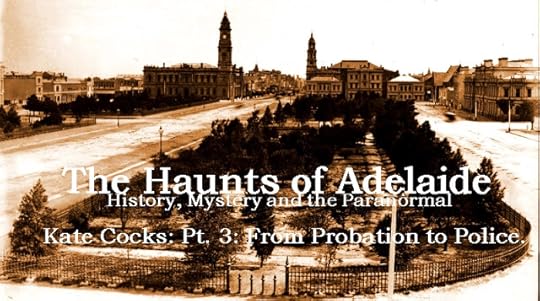
The impact of South Australia’s male population serving in World War One overseas saw a large proportion of the States females suffering, not only the worry of their male relatives and friends being away overseas, and the very real possibility of being killed in action, but also the responsibility of being able to feed their families. With the main wage earner away, women had to find work, some managed to find jobs supporting the war effort, but there weren’t enough jobs for every one, consequently, many young women turned to prostitution to support themselves and their families.
Church and community groups became concerned about the welfare of women in the state, and began to push the State Government toward employing female police officers to help alleviate the social problems they were witnessing. The Police commissioner, William Raymond, did not like the concept at all, and out-rightly dismissed the idea. A.W. Styles, the Chief Secretary, pushed harder, and turned to Crown Solicitor, Charles Dashwood, who advised there were no legal barriers to employing women as police officers. On September 27, 1915 an expression of interest, advertising for female police officers in South Australia, appeared in The Advertiser Newspaper. More than 200 women applied for the initial positions within the first week! Despite the maximum age for women to join the South Australian Police Force at the time being 29 years old, 40 year old Kate Cocks, was given the position of Principal Police Matron and offered six assistants. She declined the six assistants, and instead asked for just one, Annie Ross. (both women were over 29 years old, but the rule was waived for them to join.)
On the first of December 1915, South Australia had its first two females police officers, both serving at the same pay rate as men, a first for the British Empire. The women served from their own department, based at Victoria Square, known as “The Women Police Office”. The women mainly worked in a social welfare capacity, often they walked the areas known mainly for prostitution: Rosina Street, Light Square, and especially around Port Adelaide’s wharf's and railway station. Their first official job was to watch over women who were seen coming and going from soldier camps around the city.
Cocks said in a newspaper article many years later, about patrolling the wartime camps;
“Many of the girls we had to protect were by no means vicious but were caught up in a wave of emotionalism through a certain glamor that surrounded heroes in khaki. All along the river we patrolled and in the vicinity of the Cheer-up Hut, too.”
''Many girls were semi-hysterical over their friends going away, perhaps to be killed. People who judged them harshly did not dig down deeply enough into the cause of their unbalanced state of mind”.
Until the mid-1920’s, when Ms. Cocks applied to carry a small firearm, the women police force were armed only with a baton, police whistles, badge and ID card, and wore their own clothing. Cocks was proficient in Ju-jitsu and had taught one young lady who had suffered from an abusive husband, how to defend herself from him. Cocks went on to serve for twenty years in the South Australian Police Force, only retiring in 1935 to look after her dying mother.
Next Week: Researched and written by Allen Tiller © 2018
Bibliography on final post
Published on November 20, 2018 01:00
November 13, 2018
Kate Cocks: Pt.2: Juvenile Court Probation Officer.
Kate Cocks: Pt.2: Juvenile Court Probation Officer.
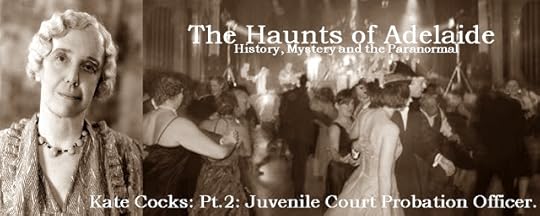
Last week, I covered Kate Cocks early years, this week, I look at how she became a Juvenile Court Probation Officer.
Overlooked by her boss, Miss Spence, at the State Children’s Department for the position of inspector, Ms Cocks set about her job to the best of her abilities, biding her time until she could apply again.
Noticing that Cocks was still eager for more responsibility, Spence put her to work researching the goings on in dance halls around the State.
At the time, Dance Halls were seen as gateways to the corruption of youth. Where teens gathered, sex, smoking, drinking and violence followed, or so was the belief at the time.
A local (female) Salvation Army Officer, Captain Phillips, thought it ill advised for Miss Cocks to travel to the dances alone (and possibly get corrupted herself) so accompanied her to each and every dance hall.
Cocks, raised a strict Methodist, had never ventured into a dance hall, watched the teens dancing together with great interest. Although she could see some benefits to young couples being together in a hall with others, as opposed to being off alone, she did not like the late hours the youth kept and thought there should be some kind of curfew enacted.
Cocks put together a very large, comprehensive report of her nightly dance hall visits. The effort she put into the report secured her a position in the Children’s Courts. She set about attending every court hearing she could to find out about the inner processes of the department.
Cocks soon concluded that no two cases could be treated the same, as children fell into criminal situations for entirely different reason than adults.
With this in mind, she took on the case of a young Adelaide choir boy, who on a lark, made of with someone’s bicycle, and rode around the city. He was duly reported by a do-gooder and found himself in front of the magistrate. The boy was found guilty upon his first offence and faced being put into a reformatory until he was 18. Cocks intervened, and took the boy in herself, taking him in and teaching him right from wrong. This incident became a test case for the whole children’s court probation system.
From this time on, Cocks began to preach the gospel of “prevention is better than reformation”, in other words, taking the children out of the situation will change their lives, rather than putting them in a reformatory to change their lives. (Note: This little passage will become very important in a future blog about Ms Cocks).
Cocks went on to work as a Juvenile Court Probation Officer for nine years.
NEXT WEEK: Kate Cocks: Pt.3: From Probation to Police
Researched and written by Allen Tiller © 2018
Bibliography on final post
Published on November 13, 2018 01:00
November 6, 2018
Kate Cocks: Pt.1: The Early Years
Kate Cocks: Pt.1: The Early Years
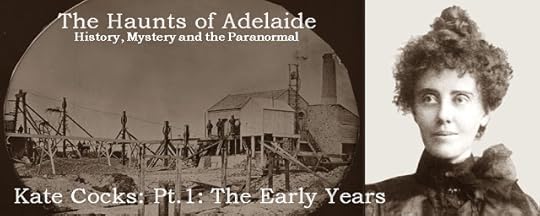
Ms Fanny Kate Boadicea Cocks (M.B.E.) was born in Moonta, South Australia on the 5th of May 1875 to parents Anthony Cocks, a miner and Elizabeth (nee George) a school teacher (Kate also had two brothers).
Mr Cocks sunk his money into a farming property near Quorn, but hard times fell upon the family and he was forced to go back to mining to pay off his debts. It was at this time, while the mid-north was in drought, that Kate learned valuable lessons about poverty that would remain with her into her adult life. It was also during this time that Kate prayed to God for rain, as the farm and its animals were suffering. That Friday rain came; this event cemented her strong Methodist beliefs that stayed with her for life.
In her teens, Kate’s father went to New South Wales to work as a miner. The rest of the family moved to Riverton, where Elizabeth worked as a school teacher.
Eventually Anthony returned home, and it was decided they would move the family to Parkside. Anthony opened a store and bakery to supplement their income.
Kate, now an adult began to look to the future, and chose her career. She decided to follow in her mothers’ footsteps and become a school teacher. She ended up getting the second job she applied for, at Edwardstown and became the School Teacher and Sub-Matron of the Receiving Home for State Children.
Kate spent the next three years working with the under-privileged. She said of her experiences there; “Sheltered in a good home I had not known anything of vice or cruelty and I never bathed a neglected baby, or tended a sad-faced dirty child, without realising that I had been led by Providence to have my vision adjusted to see life in reality and try to alter some of its in justices. How responsive to my love all those tiny ones were, and. often. I would creep away and shut myself in my wardrobe and cry a little. The wardrobe was the only private spot I could find. I am not prone to tears ordinarily, but I defy any woman, worthy of the name, to go through those three years without occasionally seeking the relief of tears.
The 'foster-mother system. I could see, needed more oversight, and my great ambition centred upon becoming an inspector. Our ordinary duties were concerned with children, from infants to girls of 21, and boys up to 18 years. But, once again, my plans were thwarted, and looking back, I see it was all part of my discipline.”
Her position at the Receiving Home, and being overlooked for another position, led to Cocks becoming interested in the state probation system for juvenile delinquents’. She studied the system and found it inadequate for the offender’s rehabilitation. Cocks soon became a
Next Week: Researched and written by Allen Tiller © 2018
Bibliography on final post.
Published on November 06, 2018 01:00
October 30, 2018
Baby in Water Closet - Colonist Tavern, Norwood.
Baby in Water Closet - Colonist Tavern, Norwood.
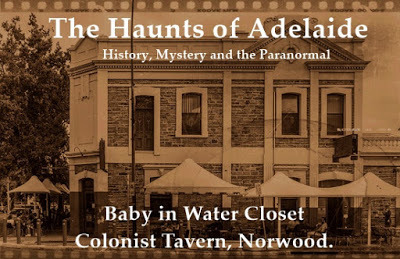
A newly born male baby, weighing 7 pounds, was found in the water closet (toilet) of the Colonist Inn on the Parade Norwood, in 1880. During the newborns autopsy, held by Dr Verco, it was revealed that child had been born recently, but was mostly likely a still born, as the child had never tried to breath. However, if the mother had of been with a mid-wife, there was evidence the child would have lived.An inquest into the death was held at Destitute Asylum on Kermode Street in Adelaide, by the City Coroner where details of how the baby came to be in the toilet were revealed.
Mary Hand, an inn servant revealed that a young lady named Ellen MacNamara visited the Old Colonist Inn on May 17th, 1880. Helen claimed to be very tired and went to bed without dinner.
The next day, Ellen helped Mary with some of her work, but collapsed. Mary helped her as best she could, and after dinner that night, did not see Ellen again to the following day at 9am.
That morning Ellen told Mary she had soiled the bedsheets and would wash them out and hang them herself. Ellen washed the sheet but left them in the soaking in the water. Before leaving, Ellen told Mary that she was planning to travel out to the country.
That evening, Mary went into Ellens room to tidy up and found that there were bloodied clothes, and blood on the mattress. She reported the soiled mattress to her bosses Mr and Mrs Bern.
Mr Bern notified the local police, that he believed a child may have been born in his hotel.
As more details emerged, it was revealed that Ellen MacNamara claimed that she had become pregnant to Sidney George Gilbert, who was a butcher living at Government Gums. Gilberts mother, Ann was called as a witness, and she revealed that Helen had visited her house, saying she was pregnant to her son Sidney.
Mrs Gilbert took the young girl in as she felt the girl might need some care. In the mean time she wrote to her son asking about Ellen and the chances of her being pregnant to him.
Sidney outright denied getting Ellen pregnant, but Mrs Gilbert allowed the girl to stay with her for 11 weeks, and in that time collected some children’s clothing for unborn child.
It was revealed to Mrs Gilbert during that 11 weeks, that Ellen did not like, nor want children.
The reason Ellen left the care of the Gilbert family was revealed. She had been sneaking out at night, and for that reason Mr Gilbert, who did not want the girl under his roof, insisted she leave.
Helen left the baby clothes at the Gilberts, still wrapped, and made her way to the Old Colonist Inn. Alfred Pickford was the next witness, a former employer of MacNamara.
MacNamara has seen Pickford wife and told her she had spent some time in the Destitute Asylum, that she had been promised marriage from a man in the country, and that the baby had died. She stated that that very morning she was released.
As it turns out, that very day, was the same day she had left the Old Colonist Inn.Miss Ellen MacNamara, it was revealed, had given birth to the child of Sidney Gilbert. Sidney had written letters to her saying he would arrange to marry her, after she had the child, and travelled to where he lived.
She had concealed her pregnancy due to being unmarried and had given birth to the still-born child in the room she rented at the Old Colonist Inn.
The Jury asked for charges of “Concealment of Birth” to be pressed by the Police on Miss MacNamara.Ellen MacNamara, 22 (sometimes known as Frawley) pleased guilty to charges of Concealment of Baby. She was sentenced to 3 months of imprisonment.
Researched and written by Allen Tiller © 2018
Bibliography
1880 'CORONER'S INQUEST.', The Express and Telegraph (Adelaide, SA : 1867 - 1922), 8 June, p. 2. (SECOND EDITION.), viewed 04 Aug 2018, http://nla.gov.au/nla.news-article2075896841880 'CORONERS' INQUESTS.', South Australian Chronicle and Weekly Mail (Adelaide, SA : 1868 - 1881), 12 June, p. 9. , viewed 04 Aug 2018, http://nla.gov.au/nla.news-article947514161880 'TELEGRAMS.', Border Watch (Mount Gambier, SA : 1861 - 1954), 9 June, p. 3. , viewed 04 Aug 2018, http://nla.gov.au/nla.news-article775883061880 'Law Courts.', South Australian Chronicle and Weekly Mail (Adelaide, SA : 1868 - 1881), 7 August, p. 10. , viewed 04 Aug 2018, http://nla.gov.au/nla.news-article947...
Published on October 30, 2018 02:00
October 23, 2018
Odious Origins of the Colonist Tavern, Norwood.
Frederick and Elizabeth Hobbs immigrated from England on board the ‘Coromandel’, the first immigrant ship to reach South Australia from London. The Coromandel transport 150 couples and 36 children and was Captained by William Chesser. It reached Kingscote, South Australia on the 10th of January 1837. One of the Hobbs claims to historical fame is that their first child, a girl, was the first Caucasian baby born in the Colony. The Hobbs third daughter, Martha, would later Marry William Brand, one of the original builders and publicans of the Overland Corner Hotel in South Australia’s Riverland.
Frederick Hobbs, a brick maker purchased land in Norwood and established the Old Colonial Inn, a single-story hotel, in 1851. (He also made the bricks for the original St johns Church of Adelaide.)Frederick Hobbs, history will show, was a disheveled drunk who was abusive to his towards his wife and family. He was convicted for assaulting his wife Elizabeth on the 22nd of January 1855. He stated that he “supposed it was all right. He had a drop of drink at the time.”
Elizabeth deposed in court that she had been married to Frederick for 20 years, they had 10 children together and had been living in the colony for 18 years. She accused Frederick of violent abuse for the previous eight years, and that he frequently slept with our women and prostitutes.
She stated that during the Gold Rush, Frederick had left for Victoria, and their baby had died. Frederick had not been paying his way, and goods from Elizabeth had seized to pay his debts.
He had returned seven months prior and had been abusive to her ever since.
The Magistrate noted that Frederick had been in court for physically abusing Mrs Hobbs only weeks previously and had broken his bond in only three days. He had pushed her out of the hotel and had gone into Adelaide and purchased an ad in the local papers telling the public not to trust his wife!
Frederick came unstuck in court when it was brought into evidence that he had been using Elizabeth Hobbs jewellery and belongings to buy time with prostitutes. One of the local Police knew the women he had been sleeping with and was able to find all the objects Mrs Hobbs described as being “sold” off by Frederick.
It was also revealed, that Frederick had kicked his wife and children out of the hotel and had been sleeping in their bed with a prostitute. Just to make matters worse, he had also put the hotel up for sale.
The Magistrate ordered that Frederick be bound by a 100 pounds bond, that he could not sell the hotel, and that he makes sure he pays maintenance to Mrs Hobbs for the children.
Local Brewers offered Mrs Hobbs to put her back into the hotel, as she had proven that she was “of ample character” to stay in business. It was not to be for Mrs Hobbs, with Frederick being charged for consecutive breaches of the Publicans Act, the hotel was quickly sold, and poor Elizabeth found herself and her children at the Destitute Asylum.
Researched and written by Allen Tiller ©2018
Bibliography
Suzanne Hirst & Ross Watts, The Story of the Coromandel in Particular the 1843 3 Masted Sailing Ship (South Australia, 2013)
1926 'MARTHA BRAND—PIONEER', Murray Pioneer and Australian River Record (Renmark, SA : 1913 - 1942), 19 November, p. 9. , viewed 04 Aug 2018, http://nla.gov.au/nla.news-article109...
1853 'BENCH OF MAGISTRATES.', Adelaide Observer (SA : 1843 - 1904), 19 March, p. 7. , viewed 04 Aug 2018, http://nla.gov.au/nla.news-article158...
1855 'POLICE COURTS.', Adelaide Observer (SA : 1843 - 1904), 24 February, p. 4. , viewed 04 Aug 2018, http://nla.gov.au/nla.news-article158...
1855 'LAW AND POLICE COURTS.', Adelaide Times (SA : 1848 - 1858), 24 January, p. 3. , viewed 04 Aug 2018, http://nla.gov.au/nla.news-article207...
Frederick Hobbs, a brick maker purchased land in Norwood and established the Old Colonial Inn, a single-story hotel, in 1851. (He also made the bricks for the original St johns Church of Adelaide.)Frederick Hobbs, history will show, was a disheveled drunk who was abusive to his towards his wife and family. He was convicted for assaulting his wife Elizabeth on the 22nd of January 1855. He stated that he “supposed it was all right. He had a drop of drink at the time.”
Elizabeth deposed in court that she had been married to Frederick for 20 years, they had 10 children together and had been living in the colony for 18 years. She accused Frederick of violent abuse for the previous eight years, and that he frequently slept with our women and prostitutes.
She stated that during the Gold Rush, Frederick had left for Victoria, and their baby had died. Frederick had not been paying his way, and goods from Elizabeth had seized to pay his debts.
He had returned seven months prior and had been abusive to her ever since.
The Magistrate noted that Frederick had been in court for physically abusing Mrs Hobbs only weeks previously and had broken his bond in only three days. He had pushed her out of the hotel and had gone into Adelaide and purchased an ad in the local papers telling the public not to trust his wife!
Frederick came unstuck in court when it was brought into evidence that he had been using Elizabeth Hobbs jewellery and belongings to buy time with prostitutes. One of the local Police knew the women he had been sleeping with and was able to find all the objects Mrs Hobbs described as being “sold” off by Frederick.
It was also revealed, that Frederick had kicked his wife and children out of the hotel and had been sleeping in their bed with a prostitute. Just to make matters worse, he had also put the hotel up for sale.
The Magistrate ordered that Frederick be bound by a 100 pounds bond, that he could not sell the hotel, and that he makes sure he pays maintenance to Mrs Hobbs for the children.
Local Brewers offered Mrs Hobbs to put her back into the hotel, as she had proven that she was “of ample character” to stay in business. It was not to be for Mrs Hobbs, with Frederick being charged for consecutive breaches of the Publicans Act, the hotel was quickly sold, and poor Elizabeth found herself and her children at the Destitute Asylum.
Researched and written by Allen Tiller ©2018
Bibliography
Suzanne Hirst & Ross Watts, The Story of the Coromandel in Particular the 1843 3 Masted Sailing Ship (South Australia, 2013)
1926 'MARTHA BRAND—PIONEER', Murray Pioneer and Australian River Record (Renmark, SA : 1913 - 1942), 19 November, p. 9. , viewed 04 Aug 2018, http://nla.gov.au/nla.news-article109...
1853 'BENCH OF MAGISTRATES.', Adelaide Observer (SA : 1843 - 1904), 19 March, p. 7. , viewed 04 Aug 2018, http://nla.gov.au/nla.news-article158...
1855 'POLICE COURTS.', Adelaide Observer (SA : 1843 - 1904), 24 February, p. 4. , viewed 04 Aug 2018, http://nla.gov.au/nla.news-article158...
1855 'LAW AND POLICE COURTS.', Adelaide Times (SA : 1848 - 1858), 24 January, p. 3. , viewed 04 Aug 2018, http://nla.gov.au/nla.news-article207...
Published on October 23, 2018 02:00
October 15, 2018
MEGAscene
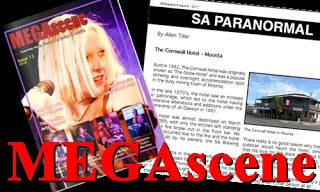 MEGAscene
MEGAsceneI’ve written articles for several magazines over the years, but the longest continual series of articles I have written is in South Australia publication, MEGAscene, published on ISSUE by Rising Sun Media.
MEGAscene first published in September 2015 and is a predominately music based photographic magazine, but also covers other events, and for a little twist, has included an article written by me about a haunting, ghost or other paranormal topic, each issue.
I thought it might be a good idea to post links to the SA Paranormal articles I have written for MEGAscene, here on this blog, as most you wont find anywhere else online.
So here they are!:
Issue 1:SA Paranormal – An introduction to Allen Tiller, and paranormal stories in South Australia. (Sept 2015)
https://issuu.com/risingstarmedia/docs/megascene_issue_1_final/34Issue 2:Kapunda – an introduction to Australia’s most haunted town. (Oct 2015)
https://issuu.com/risingstarmedia/docs/megascene_issue_2/38Issue 3:The Old Adelaide Gaol – South Australia’s most haunted location (Nov 2015)
https://issuu.com/risingstarmedia/docs/megascene_issue_3/54Issue 4:Martindale Hall – Clare – A historic haunted mansion in the Clare Valley (Jan 2016)
https://issuu.com/risingstarmedia/docs/megascene_issue_4/32Issue 5:Highercombe Hotel – Tea Tree Gully Heritage Museum (Mar 2016)
https://issuu.com/risingstarmedia/docs/megascene_issue_5/54Issue 6:The National Railway Museum – Port Adelaide (April 2016)
https://issuu.com/risingstarmedia/docs/megascene_issue_6/54Issue 7:Cornucopia Hotel – Wallaroo (June 2016)
https://issuu.com/risingstarmedia/docs/megascene_issue_7Issue 8:“The Haunted Boy” Paintings (sometimes known as the “Haunting Boy”) (Sept 2016)
https://issuu.com/risingstarmedia/docs/megascene_issue_8/32Issue 9:The Cornwall Hotel – Moonta (May2017)
https://issuu.com/risingstarmedia/docs/megascene_issue_9/46Issue 10:The Old Mount Gambier Gaol (Aug. 2017)
https://issuu.com/risingstarmedia/docs/megascene_issue_10/44Issue 11:The Royal Arms Hotel – Port Adelaide (March 2018)
https://issuu.com/risingstarmedia/docs/megascene_issue_11/56Issue 12: Ayers House – North Terrace Adelaide (July 2018)
https://issuu.com/risingstarmedia/docs/megascene_issue_12/54Issue 13: Adelaide Ghosts & Ghouls Walking Tour (Sept 2018)
https://issuu.com/risingstarmedia/docs/issue_13_of_megascene/32Issue 14:The British Hotel – Port Adelaide (yet to be released at the time of writing this blog)
You can also find MEGAscene on Facebook at: https://www.facebook.com/megasceneoz/Happy reading!
Published on October 15, 2018 15:36



